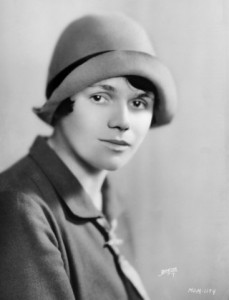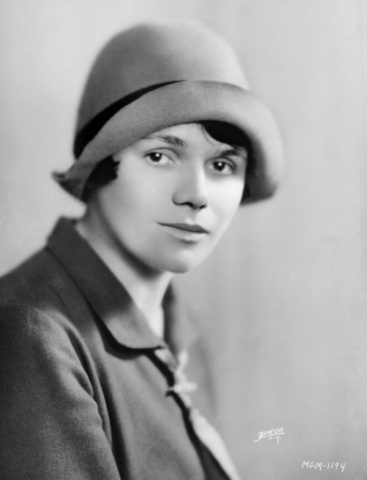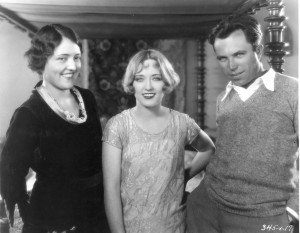Agnes Christine Johnston repeatedly claimed that she wrote and sold her first scenario, Wanted for Murder, at the age of sixteen. In 1925 she described that effort to the Los Angeles Times as a “bloodthirsty” story about a man who was tried for his own murder (D13). Perhaps she was sixteen, but she says she is “just eighteen” in the thank you letter she wrote in 1914 to Vitagraph Company of America president Albert Smith. Here she describes her ambition to go to the Columbia School of Journalism, says how happy the check he sent made her, and raves that “even dances and parties pale beside ‘movey’ writing.” We do not know if that first scenario was actually produced, but her brief description mirrors the title of a later Vitagraph film, Tried for His Own Murder (1916).

MGM publicity photo, Agnes Christine Johnston. Courtesy of the Academy of Motion Picture Arts and Sciences, Margaret Herrick Library.
However, when Johnston officially joined the film industry in 1915, it was at first not as a scenarist, but as a stenographer in Vitagraph’s Brooklyn studio, at a reported salary of $10 per week, she told the Los Angeles Times (D13). In those first few years, she wrote scenarios for comedy-dramas released by Vitagraph, the Thanhouser Company, and the Pathé Exchange. During this period, Johnston must have worked with Marguerite Bertsch, head of the Vitagraph scenario department, whose manual on how to write for motion pictures described many devices developed at the studio. In this tradition, Johnston also wrote quite thoughtfully about the new technological requirements for as well as the ancient origins of the moving picture. Not every scenario writer thought so deeply about cinema as a kind of primal expression, although the theory she espouses is not original to her, as the idea that silent cinema could convey emotions without words was popular. Lillian Gish even wrote an encyclopedia entry on motion pictures as a basic universal language.
In a 1917 Moving Picture World article, “The Comedy Scenario,” Johnston calls the “comedy-drama” the ideal photoplay because the motion picture is “elemental.” In its reliance on “action,” she says, it hearkens back to the caveman: “It provokes first emotions, and then thought through those emotions,” through the “primal feelings” of laughter and tears. She also insists that the silent cinema not rely on the spoken word, claiming that it must be “more vital and ever-changing.” In the vocabulary emerging in the silent era, she also mentions the necessity of “continuity” (413). Her use of the term “continuity” here is interesting as it seems to encompass the term’s various meanings—from a script that facilitated efficient shooting to the way writing in conjunction with editing could produce a story that the viewer experienced as smooth and uninterrupted (Staiger 1985, 189–91).
In an article titled “A Feat in Photography” she describes writing the scenario for the extant title An Old Fashioned Boy (1920) as involving transitions between scenes that could be made without the use of silent film’s trademark iris shots. A writer, she suggested, might create transitions by the use of contrasting scenes, following action sequences with a love scene or “bit of human interest.” Although this article refers to the “continuous” approach to scene transitions as a “novelty” allowing spectators to experience a story “unfolding” without the interruption of either a “break” or a “fade,” she is in fact describing common industry practice (63). This development away from transitions that called attention to themselves in favor of smooth storytelling would have been the new industry standard by 1920 (Staiger 1985, 189–91).
In the summer of 1918, Agnes Johnston enrolled in Professor George P. Baker’s playwriting class at Harvard College, and in 1919 she became “special scenario editress” for Mary Pickford, Moving Picture World reported in 1919 (744). The amazing Daddy-Long-Legs (1919) appeared during this period, a Johnston adaptation that would become one of the films that defined Pickford’s distinctive character as the poor girl capable of changing the hearts of the rich. The extant film, produced by the Mary Pickford Motion Picture Corporation, is carefully structured to display the comedian’s use of comic incongruity, pleasing contemporary audiences with a surprising formula that effectively combines funny and poignant elements. Holding up equally well are the two extant comedies, the first silent and the second sound, that Johnston wrote for Marion Davies—The Patsy (1928) and Show People (1928)—both directed by King Vidor while she was under contract to Metro-Goldwyn-Mayer. In recent years The Patsy has been rediscovered and was screened in 2002 at the Italian silent film festival, Le Giornate del Cinema Muto.
During her years at Metro-Goldwyn-Mayer, Johnston’s salary made the newspapers. The Los Angeles Times, in an article on “penwomen” in Hollywood, estimated Johnston’s 1924 salary as $50,000 a year, or roughly $1,000 per week. She had just moved from working as a freelance writer to being under “long-term contract” with Metro-Goldwyn-Mayer (C14). In 1925, the Los Angeles Times described her job at MGM as assessing plays for their viability of screen adaptation and securing rights (D13). At the same time, she was writing for important talent, as her work with Marion Davies during the MGM years attests. In fact, four years later the Los Angeles Times singled out Johnston as one of a very few women then under contract to a major production company, describing her as an important name in film writing circles and, by 1928, still “one of the highest paid women scenarists” in the industry (C11). Director Paul Bern even remarked to the Los Angeles Times in 1925 that Johnston was among five scenarists, along with one other woman, Frances Marion, who he felt deserved the title “screen specialist” (A9).
Agnes Christine Johnston may have been overshadowed by Marion, her legendary Metro-Goldwyn-Mayer scenario department coworker. Now, in examining Johnston’s career, we find that not only did she write or co-write circa forty original screenplays, but she also turned out adaptations in collaboration with her husband, the scenarist and playwright Frank Mitchell Dazey. For several years, between 1920 and 1936, the couple worked as co-authors, and the press frequently remarked on their successful professional collaborations, with one article titled “Mix Careers and Marriage” referring to them as “The Gold Dust Twins of Screen and Stage” (D11). Although we now know that many couples worked as creative teams in the silent era, Dazey and Johnston are less like the more visible writing-directing-acting teams such as Lois Weber and Phillips Smalley and more like Mr. and Mrs. George Randolph Chester —whose forte was joint scenario writing. Johnston and Dazey may also have been the only husband-wife team to cowrite a serial, The Jungle Goddess (1922), a project they undertook for the small Export-Import Film Company. This chapter play tells the story of a European girl who is kidnapped and tossed into the basket of a hot-air balloon only to be lost in the jungles of Africa where she becomes the “white goddess” of an African tribe. Surprisingly, ten of the fifteen episodes are extant, as are at least three other co-authored titles—Silk Hosiery (1920), produced by Famous Players-Lasky and distributed by Paramount Pictures Corporation; The Tomboy (1924) produced by Mission Film Corporation; and For Another Woman (1924). The latter was produced by the newly formed low-budget Rayart Pictures, which would become Monogram Pictures in 1930 (Slide 1998, 129).
While directors like Johnston and Weber benefited from the industry assumption that female directors would attract female spectators, this practice only held sway from about 1916–1923, after which time the industry changed course. The situation for scenario writers was slightly different as a relatively greater number of women continued to find studio as well as freelance writing work in the silent to sound transition period. One question that remains unanswered is whether the “woman’s-angle” justification for hiring women writers persisted. Defending women writers in 1924, Samuel Goldwyn sounds like a throwback to the previous decade when a new industry used women directors and scenario writers to shore up their respectability. In 1924, in an article mentioning Agnes Christine Johnston, the Los Angeles Times quotes veteran producer and head of a new company, Samuel Goldwyn, as saying, “Approximately 50 per cent of moving-picture audiences are composed of feminine spectators. So it is but natural that women make the best screen writers. They know better than men the tricks which catch the feminine mind and the little things that appeal to every class of audience” (C10). Always an advocate of women in the motion picture industry, Johnston agreed with a position held by a number of others, most notably scenario writer Clara Beranger, that women’s special aptitudes made them potentially the equal of men as directors. In 1927, Johnston stated, “I see no reason why women shouldn’t make very good directors. They may not be quite as good at inserting spectacular touches, but for photoplays of intimate characterization—and these usually mean the best drama—they should easily equal or surpass men” (350). These comments suggest how quickly the new industry players seem to have forgotten prolific directors Weber and Alice Guy-Blaché, whose careers had come to an end by the early 1920s.
It may be more difficult to assess the careers of scenario writers, if only because of a long tradition of freelance work in all writing fields and the blurring of the distinction between professional and part-time work, particularly among women writers. Johnston announced her retirement from film in 1929, opting to focus on writing for the stage and magazines, but the Hartford Courant announced her return to scenario writing in 1931 with the headline, “Hollywood Lure Too Strong for Agnes Johnston” (3B). In 1935, Moving Picture World made a similar proclamation when it announced Johnston “Signs with M-G-M” (629). That same year, Alma Whitaker, writing in the Los Angeles Times, proclaimed that women directors and scenario writers began to “lose ground to men” with the advent of sound (A1). Agnes Johnston, however, was one of a handful of women writers (the list included other experienced professionals such as Marion, Sonya Levien, and Lenore Coffee) who continued to work on film scenarios well into the sound period.
In addition to developing a reputation as a celebrated member of the motion picture industry, Agnes Christine Johnston was also one of Hollywood’s social trendsetters, with reporters remarking on her riding in celebrity steeplechase and polo matches, hosting popular ping-pong parties, and traveling around Paris with her newborn son in a handbasket. Reporters frequently commented on her remarkable ability to balance a demanding Hollywood career and a family. Johnston’s response to inquiries about this juggling act, as quoted in 1928 in the Los Angeles Times, sounds rather modern: “I think women have too much creative energy to spend it merely on housekeeping. You get neurasthenic if you have only one line. I notice it is the young mothers who devote themselves too intensely to their offspring who get nervous break-downs: also the society women who only do society, and writers who only write. When you have two young scenarios as well as two young children on your hands, you find each a relaxation and a joy. You don’t break down” (C11).
In a career that began in 1915 at Vitagraph and lasted for approximately thirty-five years, Agnes Christine Johnson became an increasingly prolific, high-profile member of the film community, writing scenarios, adaptations, or continuities for more than sixty films for a number of independent companies as well as for the emerging major motion picture company Metro-Goldwyn-Mayer. She wore many hats throughout her career, including authoring a popular stage comedy, “Funny Little Things,” which premiered at Los Angeles’ Morosco Theatre in 1928 to very positive reviews. Though author Ayn Rand described it as a “silly play about office girls’ love,” (42) Johnston claimed, in a 1928 Los Angeles Times article that several production companies had expressed interest in adapting the successful stage comedy (A11). Johnston also continued to collaborate with her husband on stage productions, and in 1966 the couple published a children’s book, Pepe, the Bad One, whose protagonist she described as a “Mexican Andy Rooney.” According to the author bio printed on the jacket, the book was inspired by Johnston and Dazey’s experience working as the volunteer managers of a dispensario, or free clinic. In addition to the popular Andy Hardy films of the 1940s, she also wrote serial magazine stories and newspaper etiquette columns, and eventually wrote for television.


